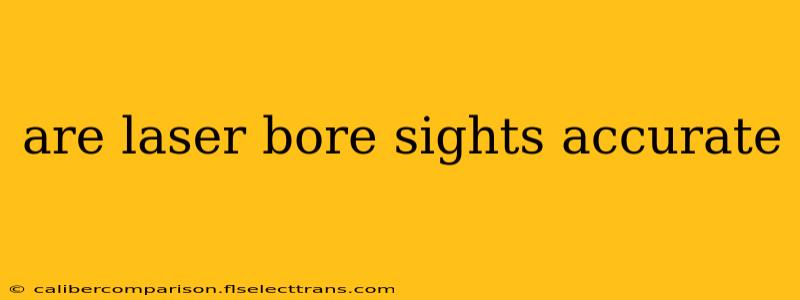Laser bore sights have surged in popularity among firearm enthusiasts, promising unparalleled accuracy during zeroing and sighting-in processes. But how accurate are they really? This in-depth analysis explores the capabilities and limitations of laser bore sights, examining factors influencing their precision and their practical applications.
Understanding Laser Bore Sight Technology
Laser bore sights utilize a small laser diode inserted into the firearm's barrel, emitting a laser beam that precisely aligns with the bore. This projected beam allows shooters to quickly and easily align their sights with the barrel's trajectory without expending ammunition. This is particularly useful for:
- Zeroing rifles and pistols: Quickly establishing a zero point at various distances.
- Checking sight alignment: Verifying the proper alignment of iron sights or optical scopes.
- Troubleshooting firearm malfunctions: Identifying potential issues with barrel alignment or sight problems.
Factors Affecting Accuracy
While laser bore sights offer a convenient method for initial sight alignment, several factors can influence their accuracy:
1. Laser Beam Divergence:
Laser beams aren't perfectly straight lines; they diverge (spread out) over distance. This divergence is minimal at closer ranges but becomes more pronounced as the distance increases. This means the accuracy of the laser's projection decreases at longer ranges, potentially impacting the precision of your zeroing process.
2. Bore Alignment:
The laser must be perfectly centered within the bore to guarantee accurate results. Any misalignment, however slight, will introduce errors. Improper installation or a damaged laser bore sight can lead to significant inaccuracy.
3. Environmental Factors:
Temperature fluctuations and wind conditions can affect the laser beam's trajectory, leading to inaccuracies. While these effects might be minor at shorter ranges, they can accumulate at longer distances, creating deviations from the actual bullet path.
4. Ammunition Variations:
While the laser bore sight aligns with the barrel, the bullet's actual trajectory can be influenced by factors like ammunition type, bullet weight, and powder charge. These factors can create slight differences between the laser's path and the actual bullet's path.
Practical Considerations and Accuracy Expectations
Laser bore sights are most accurate at close ranges. Their accuracy diminishes considerably as the distance to the target increases. While they're not a replacement for proper sighting-in at the range with live ammunition, they provide a convenient starting point for many firearm owners. Expect minor adjustments after using a laser bore sight to fully zero your firearm accurately.
Think of laser bore sights as tools to achieve a close approximation of the ideal zero, not as instruments offering pinpoint accuracy at long ranges. They are most effective for:
- Rough zeroing: Establishing a starting point for fine-tuning at the shooting range.
- Confirming sight alignment: Ensuring your sights are properly aligned with the barrel.
- Quick checks: A fast method for verifying if significant changes have occurred (like after cleaning or transportation).
Conclusion: Accuracy Depends on Context
The accuracy of a laser bore sight is context-dependent. While not perfectly precise at longer ranges, they remain valuable tools for various tasks. Understanding the factors influencing accuracy and managing expectations are crucial for utilizing these devices effectively. Always follow up with live fire zeroing at the range to ensure optimal precision for your specific firearm and ammunition.

